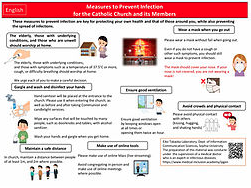
International Mass (led by the Japanese Group)
Today, since we are commemorating Bl. Takayama Ukon in this International Mass, I want to tell you something about him. I wondered why we are remembering him in this Mass. I think it is because he is a model for us Christians in the Church in Japan.

In today's second reading, St. Paul says this. "No one of us lives for himself, and no one dies for himself; for if we live, we live for the Lord, and if we die, we die for the Lord." These words remind me of Bl. Takayama Ukon.
As you may know, Takayama Ukon was a warlord of the Sengoku period. He was exiled to Manila because of his faith and died there. He was not killed in Manila, but he was remembered as a martyr. This has a significant meaning. That is, martyrdom is not about shedding blood, but about giving up one's daily life. There is a martyrdom that does not involve dying. There is a martyrdom while living. It is all about offering our daily challenges.
Ukon’s path of faith was not a smooth one. He had a painful experience while young that triggered his conversion. He fought a duel with a warlord, and although he himself was wounded, he killed the enemy. It was an experience that caused him to reevaluate his life and his faith. In that way, he is like St. Ignatius of Loyola.
After Toyotomi Hideyoshi confiscated Ukon’s territory because of his Christian faith, he was exiled to the island of Shodojiima for eight months. According to documents, the Jesuit Father Organtino served as his spiritual advisor and held weekly spiritual conversations with him. It is also recorded that Father Organtino recommended the Spiritual Exercises of Ignatius to Takayama Ukon at that time. It is also recorded that Ukon made the 30-day Spiritual Exercises in Shimabara before he was exiled to Kanazawa.
Ukon spent 26 years in Kanazawa. He was later exiled to Manila by Tokugawa Ieyasu's decree banning Christianity and died there the following year. Before he was exiled to Manila, Ukon made the Spiritual Exercises again in Nagasaki. At that time, Nagasaki was experiencing persecution. It was a time of great turmoil for the Christians. It divided the Christians and the various religious orders working there. Despite all this, he did the Ignatian Spiritual Exercises to prepare his heart and soul before the final departure. In the end, he chose the better way of exile, and went to Manila. His Martyrdom was a fruit of discernment.
I want to present three points that we can learn from Bl. Takayama Ukon. One is the Ignatian Spiritual Exercises. Have you ever heard about the Spiritual Exercises of St. Ignatius of Loyola? Have you experienced them? Since you are attending a Jesuit Church named after St. Ignatius, I want you to become more familiar with the Spiritual Exercises. It is a way of intensive prayer that prepares our mind, heart, and soul to follow Christ. The core of the Spiritual Exercise is discernment; What does God want from me? What do I want deep in my heart? That means listening to my holy desires and the voice of God calling to me without being distracted by my surroundings. In this way, Ukon rejected repeated invitations to deny the faith. He finally accepted going to Manila because of his faith, not as a passive act of just being sent away. Before leaving Japan, he wrote a letter to his close friend Hosokawa Tadaoki, the husband of Hosokawa Gratia. "I will go to the South Seas and pour my life and name into heaven."
Second, we cannot hope to grow as human beings or in faith if we remain in our comfort zones. Because of his faith, Ukon was not allowed to stay in his territory but had to move from place to place. It was as if God told him to go elsewhere he didn't know where he was going. I found this quotation from someone, "Real growth happens and real grace breaks in when we have to deal with the other, the strange, the different, the unfamiliar. The frightening and the uninvited will stretch us in ways that the familiar and the secure cannot." That is so true in the life of Ukon.
Finally, let's look at his journey of faith. He saw his friends risking their lives and dying for their faith. In that sense, he probably wished he could die too. But his style of martyrdom was a martyrdom without blood. It is a martyrdom in the very act of living. It is a testimony of faith that he lived as a believer in Christ. We, too, can live this daily martyrdom. For example, we can live our "living martyrdom" at home, raising children, doing housework, and caring for others. We can live it at work, in society as well. New challenges sometimes arise without a change of place. Such challenges make us stronger as humans and as believers.
This is a martyrdom without dying. It is a martyrdom that we live out. Let us ask Bl. Takayama Ukon to intercede for us so that we can follow Christ by offering our daily challenges as living martyrdom. Bl. Takayama Ukon, pray for us!
HOMILY given by Fr. Yosuke Sakai, SJ
 ENGLISH
ENGLISH  ESPAÑOL
ESPAÑOL 






